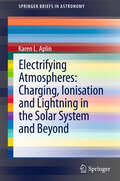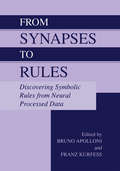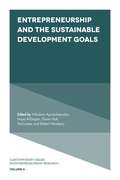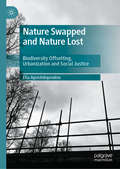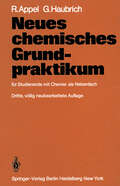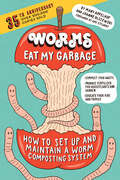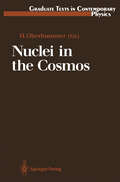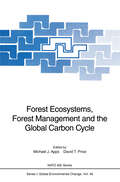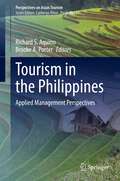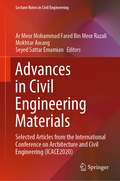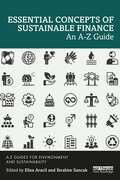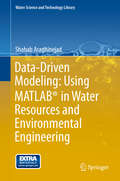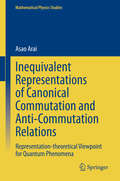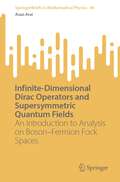- Table View
- List View
Electrifying Atmospheres: Charging, Ionisation and Lightning in the Solar System and Beyond (SpringerBriefs in Astronomy)
by Karen AplinElectrical processes take place in all planetary atmospheres. There is evidence for lightning on Venus, Jupiter, Saturn, Uranus and Neptune, it is possible on Mars and Titan, and cosmic rays ionise every atmosphere, leading to charged droplets and particles. Controversy surrounds the role of atmospheric electricity in physical climate processes on Earth; here, a comparative approach is employed to review the role of electrification in the atmospheres of other planets and their moons. This book reviews the theory, and, where available, measurements, of planetary atmospheric electricity, taken to include ion production and ion-aerosol interactions. The conditions necessary for a global atmospheric electric circuit similar to Earth’s, and the likelihood of meeting these conditions in other planetary atmospheres, are briefly discussed. Atmospheric electrification is more important at planets receiving little solar radiation, increasing the relative significance of electrical forces. Nucleation onto atmospheric ions has been predicted to affect the evolution and lifetime of haze layers on Titan, Neptune and Triton. For planets closer to Earth, heating from solar radiation dominates atmospheric circulations. Mars may have a global circuit analogous to the terrestrial model, but based on electrical discharges from dust storms, and Titan may have a similar global circuit, based on transfer of charged raindrops. There is an increasing need for direct measurements of planetary atmospheric electrification, in particular on Mars, to assess the risk for future unmanned and manned missions. Theoretical understanding could be increased by cross-disciplinary work to modify and update models and parameterisations initially developed for a specific atmosphere, to make them more broadly applicable to other planetary atmospheres. The possibility of electrical processes in the atmospheres of exoplanets is also discussed.
From Synapses to Rules: Discovering Symbolic Rules from Neural Processed Data
by Bruno Apolloni Franz KurfessOne high-level ability of the human brain is to understand what it has learned. This seems to be the crucial advantage in comparison to the brain activity of other primates. At present we are technologically almost ready to artificially reproduce human brain tissue, but we still do not fully understand the information processing and the related biological mechanisms underlying this ability. Thus an electronic clone of the human brain is still far from being realizable. At the same time, around twenty years after the revival of the connectionist paradigm, we are not yet satisfied with the typical subsymbolic attitude of devices like neural networks: we can make them learn to solve even difficult problems, but without a clear explanation of why a solution works. Indeed, to widely use these devices in a reliable and non elementary way we need formal and understandable expressions of the learnt functions. of being tested, manipulated and composed with These must be susceptible other similar expressions to build more structured functions as a solution of complex problems via the usual deductive methods of the Artificial Intelligence. Many effort have been steered in this directions in the last years, constructing artificial hybrid systems where a cooperation between the sub symbolic processing of the neural networks merges in various modes with symbolic algorithms. In parallel, neurobiology research keeps on supplying more and more detailed explanations of the low-level phenomena responsible for mental processes.
Entrepreneurship and the Sustainable Development Goals (Contemporary Issues in Entrepreneurship Research #8)
by Nikolaos Apostolopoulos Haya Al-Dajani Diane Holt Paul Jones Robert NewberyThe sustainable development goals (SDGs) were launched in 2015, as a global agenda for addressing the multiplicity of social and environmental challenges that face communities around the world. But what role might entrepreneurship play in reaching these goals? In the first book of its kind, Entrepreneurship and the Sustainable Development Goals will encourage you to think about the critical role that entrepreneurship and entrepreneurs might play in supporting sustainable development. More than twenty authors from across Africa, Asia, North America, and Europe explore a fascinating mix of enterprises and sustainable development initiatives to illustrate the capacity of entrepreneurship as the engine for transforming our world and overcoming the diverse nature of these global challenges. Structured into three provocative sections this book explores: • Social change and entrepreneurship through the lens of the SDGs; • Organisational practices and innovation towards the SDGs; • Entrepreneurship, gender equality and empowerment towards the SDGs Journey through the stories of tribal enterprises in India, to cacao framers in Ghana, small and medium sized businesses in Greece, social enterprises in Kenya, Zambia and the USA and many others to see the powerful force that entrepreneurship can be for promoting poverty alleviation and sustainable development.
Entrepreneurship and the Sustainable Development Goals (Contemporary Issues in Entrepreneurship Research #8)
by Nikolaos Apostolopoulos Haya Al-Dajani Diane Holt Paul Jones Robert NewberyThe sustainable development goals (SDGs) were launched in 2015, as a global agenda for addressing the multiplicity of social and environmental challenges that face communities around the world. But what role might entrepreneurship play in reaching these goals? In the first book of its kind, Entrepreneurship and the Sustainable Development Goals will encourage you to think about the critical role that entrepreneurship and entrepreneurs might play in supporting sustainable development. More than twenty authors from across Africa, Asia, North America, and Europe explore a fascinating mix of enterprises and sustainable development initiatives to illustrate the capacity of entrepreneurship as the engine for transforming our world and overcoming the diverse nature of these global challenges. Structured into three provocative sections this book explores: • Social change and entrepreneurship through the lens of the SDGs; • Organisational practices and innovation towards the SDGs; • Entrepreneurship, gender equality and empowerment towards the SDGs Journey through the stories of tribal enterprises in India, to cacao framers in Ghana, small and medium sized businesses in Greece, social enterprises in Kenya, Zambia and the USA and many others to see the powerful force that entrepreneurship can be for promoting poverty alleviation and sustainable development.
The Sociology of Tourism: Theoretical and Empirical Investigations (Routledge Advances in Tourism)
by Yiorgos Apostolopoulos Stella Leivadi Andrew YiannakisThe rapid expansion of the tourism industry has provided many economic benefits and affected every facet of contemporary societies including employment, government revenue and cultural manifestations. However, tourism can also be considered a problematic phenomenon, promoting dependency, underdevelopment and adverse sociocultural effects, especially for developing countries. This pioneering work provides a comprehensive review of these complex tourism issues from a sociological perspective. Various theoretical and empirical approaches are introduced and the following issues are discussed: * identifiable and stable forms of touristic behaviour and roles* social divisions within tourism* the interdependence of tourism and social institutions* the effects of transnational tourism and commodification on the ecosystem.Featuring international contributions from nine different countries, this book brings together the most noted theoretical and empirical studies and enriches them with diverse experiences and perspectives.
The Sociology of Tourism: Theoretical and Empirical Investigations (Routledge Advances in Tourism #Vol. 1)
by Yiorgos Apostolopoulos Stella Leivadi Andrew YiannakisThe rapid expansion of the tourism industry has provided many economic benefits and affected every facet of contemporary societies including employment, government revenue and cultural manifestations. However, tourism can also be considered a problematic phenomenon, promoting dependency, underdevelopment and adverse sociocultural effects, especially for developing countries. This pioneering work provides a comprehensive review of these complex tourism issues from a sociological perspective. Various theoretical and empirical approaches are introduced and the following issues are discussed: * identifiable and stable forms of touristic behaviour and roles* social divisions within tourism* the interdependence of tourism and social institutions* the effects of transnational tourism and commodification on the ecosystem.Featuring international contributions from nine different countries, this book brings together the most noted theoretical and empirical studies and enriches them with diverse experiences and perspectives.
Nature Swapped and Nature Lost: Biodiversity Offsetting, Urbanization and Social Justice
by Elia ApostolopoulouThis book unravels the profound implications of biodiversity offsetting for nature-society relationships and its links to environmental and social inequality. Drawing on people’s resistance against its implementation in several urban and rural places across England, it explores how the production of equivalent natures, the core promise of offsetting, reframes socionatures both discursively and materially transforming places and livelihoods.The book draws on theories and concepts from human geography, political ecology, and Marxist political economy, and aims to shift the trajectory of the current literature on the interplay between offsetting, urbanization and the neoliberal reconstruction of conservation and planning policies in the era following the 2008 financial crash. By shedding light on offsetting’s contested geographies, it offers a fundamental retheorization of offsetting capable of demonstrating how offsetting, and more broadly revanchist neoliberal policies, are increasingly used to support capitalist urban growth producing socially, environmentally and geographically uneven outcomes. Nature Swapped and Nature Lost brings forward an understanding of environmental politics as class politics and sees environmental justice as inextricably linked to social justice. It effectively challenges the dystopia of offsetting’s ahistorical and asocial non-places and proposes a radically different pathway for gaining social control over the production of nature by linking struggles for the right to the city with struggles for the right to nature for all.
Worms Eat My Garbage, 35th Anniversary Edition: How to Set Up and Maintain a Worm Composting System: Compost Food Waste, Produce Fertilizer for Houseplants and Garden, and Educate Your Kids and Family
by Mary Appelhof Joanne OlszewskiFor more than three decades, this best-selling guide to the practice of vermicomposting has taught people how to use worms to recycle food waste into nutrient-rich fertilizer for houseplants or gardens. Small-scale, self-contained worm bins can be kept indoors, in a basement, or even under the kitchen sink in an apartment — making vermicomposting a great option for city dwellers and anyone who doesn&’t want or can&’t have an outdoor compost pile. The fully revised 35th anniversary edition features the original&’s same friendly tone, with up-to-date information on the entire process, from building or purchasing a bin (readily available at garden supply stores) to maintaining the worms and harvesting the finished compost.
Quantum Independent Increment Processes I: From Classical Probability to Quantum Stochastic Calculus (Lecture Notes in Mathematics #1865)
by David Applebaum B.V. Rajarama Bhat Johan Kustermans J. Martin LindsayThis volume is the first of two volumes containing the revised and completed notes lectures given at the school "Quantum Independent Increment Processes: Structure and Applications to Physics". This school was held at the Alfried-Krupp-Wissenschaftskolleg in Greifswald during the period March 9 – 22, 2003, and supported by the Volkswagen Foundation. The school gave an introduction to current research on quantum independent increment processes aimed at graduate students and non-specialists working in classical and quantum probability, operator algebras, and mathematical physics. The present first volume contains the following lectures: "Lévy Processes in Euclidean Spaces and Groups" by David Applebaum, "Locally Compact Quantum Groups" by Johan Kustermans, "Quantum Stochastic Analysis" by J. Martin Lindsay, and "Dilations, Cocycles and Product Systems" by B.V. Rajarama Bhat.
Integrated Sustainable Design of Buildings
by Paul ApplebyIntegrated Sustainable Design of Buildings aims to provide a guide to members of design and masterplanning teams on how to deliver sustainable development and buildings cost effectively, meeting current and emerging UK and international statutory and planning requirements. Using a series of case histories and examples from the author's ten years of providing sustainability advisory services the book sets out a clear and understandable strategy that deals with all aspects of sustainable design and construction and the implications for delivery, costs, saleability and long term operation. The extensive scope includes all aspects of environmental, social and economic sustainability, including strategies to reduce carbon emissions and the impact of climate change. Integrated Sustainable Design of Buildings appeared in the Cambridge Top 40 Sustainability Books of 2010.
Integrated Sustainable Design of Buildings
by Paul ApplebyIntegrated Sustainable Design of Buildings aims to provide a guide to members of design and masterplanning teams on how to deliver sustainable development and buildings cost effectively, meeting current and emerging UK and international statutory and planning requirements. Using a series of case histories and examples from the author's ten years of providing sustainability advisory services the book sets out a clear and understandable strategy that deals with all aspects of sustainable design and construction and the implications for delivery, costs, saleability and long term operation. The extensive scope includes all aspects of environmental, social and economic sustainability, including strategies to reduce carbon emissions and the impact of climate change. Integrated Sustainable Design of Buildings appeared in the Cambridge Top 40 Sustainability Books of 2010.
Sustainable Retrofit and Facilities Management
by Paul ApplebyGovernments across the globe are setting targets for reducing their carbon emissions. For example, the UK Government has committed to an eighty per cent reduction by 2050, when twenty-eight million buildings that currently exist will still be standing; this represents a challenge to improve the energy efficiency of more than one building per minute between now and 2050! This is a problem that needs tackling worldwide and is a challenge to both the refurbishment sector of the global construction industry and to those who own and operate existing buildings. Sustainable Retrofit and Facilities Management provides comprehensive guidance to those involved in the refurbishment and management of existing buildings on minimizing carbon emissions, water consumption and waste to landfill, along with enhancing the long term sustainability of a building. Practical guidance is provided on measures that can be used to improve the efficiency and sustainability of existing buildings, through both good management and refurbishment. Also explored is the relationship between the refurbishment of existing buildings, facility management and the wider community infrastructure. The book looks at management tools such as post occupancy evaluation, building health checks, energy management software, green building management toolkits and green leases. Illustrated throughout with case studies and examples of best practice, this is a must-have handbook for engineers, architects, developers, contractors and facility managers.
Sustainable Retrofit and Facilities Management
by Paul ApplebyGovernments across the globe are setting targets for reducing their carbon emissions. For example, the UK Government has committed to an eighty per cent reduction by 2050, when twenty-eight million buildings that currently exist will still be standing; this represents a challenge to improve the energy efficiency of more than one building per minute between now and 2050! This is a problem that needs tackling worldwide and is a challenge to both the refurbishment sector of the global construction industry and to those who own and operate existing buildings. Sustainable Retrofit and Facilities Management provides comprehensive guidance to those involved in the refurbishment and management of existing buildings on minimizing carbon emissions, water consumption and waste to landfill, along with enhancing the long term sustainability of a building. Practical guidance is provided on measures that can be used to improve the efficiency and sustainability of existing buildings, through both good management and refurbishment. Also explored is the relationship between the refurbishment of existing buildings, facility management and the wider community infrastructure. The book looks at management tools such as post occupancy evaluation, building health checks, energy management software, green building management toolkits and green leases. Illustrated throughout with case studies and examples of best practice, this is a must-have handbook for engineers, architects, developers, contractors and facility managers.
Nuclei in the Cosmos (Graduate Texts in Contemporary Physics)
by J. H. Applegate J. J. Cowan F. Käppeler H.V. Klapdor-Kleingrothaus K. Langanke R. A. Malaney H. Oberhummer B.E.J. Pagel C. Rolfs G. Schatz G. Staudt F. K. Thielemann J. Vervier M. WiescherNuclear astrophysics as it stands today is a fascinating science. Even though, compared to other scientific fields, it is a young discipline which has developed only in this century, it has answered many questions concerning the under standing of our cosmos. One of these great achievements was the concept of nucleosynthesis, the creation of the elements in the early universe in interstellar matter and in stars. Nuclear astrophysics has continued, to solve many riddles of the evolution of the myriads of stars in our cosmos. This review volume attempts to provide an overview of the current status of nuclear astrophysics. Special emphasis is given to the interdisciplinary nature of the field: astronomy, nuclear physics, astrophysics and particle physics are equally involved. One basic effort of nuclear astrophysics is the collection of ob servational facts with astronomical methods. Laboratory studies of the nuclear processes involved in various astrophysical scenarios have provided fundamen tal information serving both as input for and test of astrophysical models. The theoretical understanding of nuclear reaction mechanisms is necessary, for example, to extrapolate the experimentally determined reaction rates to the thermonuclear energy range, which is relevant for the nuclear processes in our cosmos. Astrophysical models and calculations allow us to simulate how nuclear processes contribute to driving the evolution of stars, interstellar matter and the whole universe. Finally, elementary particle physics also plays an important role in the field of nuclear astrophysics, for instance through weak interaction processes involving neutrinos.
Values in Sustainable Development (Routledge Studies in Sustainable Development)
by Jack AppletonTo enhance sustainable development research and practice the values of the researchers, project managers and participants must first be made explicit. Values in Sustainable Development introduces and compares worldviews and values from multiple countries and perspectives, providing a survey of empirical methods available to study environmental values as affected by sustainable development. The first part is methodological, looking at what values are, why they are important, and how to include values in sustainable development. The second part looks at how values differ across social contexts, religions and viewpoints demonstrating how various individuals may value nature from a variety of cultural, social, and religious points of view. The third and final part presents case studies ordered by scale from the individual and community levels through to the national, regional and international levels. These examples show how values can motivate, be incorporated into and be an integral part of the success of a project. This thought-provoking book gives researchers, students and practitioners in sustainable development a wealth of approaches to include values in their research.
Values in Sustainable Development: Values In Sustainable Development (Routledge Studies in Sustainable Development)
by Jack AppletonTo enhance sustainable development research and practice the values of the researchers, project managers and participants must first be made explicit. Values in Sustainable Development introduces and compares worldviews and values from multiple countries and perspectives, providing a survey of empirical methods available to study environmental values as affected by sustainable development. The first part is methodological, looking at what values are, why they are important, and how to include values in sustainable development. The second part looks at how values differ across social contexts, religions and viewpoints demonstrating how various individuals may value nature from a variety of cultural, social, and religious points of view. The third and final part presents case studies ordered by scale from the individual and community levels through to the national, regional and international levels. These examples show how values can motivate, be incorporated into and be an integral part of the success of a project. This thought-provoking book gives researchers, students and practitioners in sustainable development a wealth of approaches to include values in their research.
Forest Ecosystems, Forest Management and the Global Carbon Cycle (Nato ASI Subseries I: #40)
by Michael J. Apps David T. PriceGlobally, forest vegetation and soils are both major stores of terrestrial organic carbon, and major contributors to the annual cycling of carbon between the atmosphere and the biosphere. Forests are also a renewable resource, vital to the everyday existence of millions of people, since they provide food, shelter, fuel, raw materials and many other benefits. The combined effects of an expanding global population and increasing consumption of resources, however, may be seriously endangering both the extent and future sustainability of the world's forests. About thirty chapters cover four main themes: the role of forests in the global carbon cycle; effects of past, present and future changes in forest land use; the role of forest management, products and biomass on carbon cycling, and socio-economic impacts.
Tourism in the Philippines: Applied Management Perspectives (Perspectives on Asian Tourism)
by Richard S. Aquino Brooke A. PorterThis edited book serves as the first instalment of a two-part title that aims to provide an academic exploration of the contemporary issues and perspectives on tourism in the Philippines. With a strong geographical focus, this book is the first country-focused volume under the series, Perspectives on Asian Tourism. Comprised of chapters based on conceptual and empirical research, this book aims to develop a foundational and practical knowledge base on Philippine tourism management. The chapters cover a range of national, regional, and local tourism management issues that cut across the following themes:• Governance issues in Philippine tourism destinations• The Tourism Act of 2009 • Tourism impacts and sustainability• Innovative tourism development strategies• Tourism marketing campaigns (i.e., It's More Fun in the Philippines!)• Philippine tourism and the ASEAN integration• Tourism and hospitality education in the PhilippinesThe contributions are drawn from the works of Filipino academics based in the Philippines and overseas institutions, and international academics researching tourism issues in the Philippines. The chapters are informed by a diverse set of disciplines including, but not limited to tourism studies, hospitality management, marketing, human resources management, public policy, environmental management, community development, and education.This edited book is divided into four parts: first, an introduction to the development of policy and contemporary management issues in Philippine tourism; second, nature-based tourism and the natural environment; third, product development and branding; and fourth, accreditation and industry standards. The volume culminates with a synthesis of the progress of Philippine tourism development and management implications using the cases and experiences outlined in the chapters. This book serves as a systematic guide to the current state of tourism development and management in the Philippines, and as essential reading for undergraduate and postgraduate students, researchers, educators, and, more importantly, tourism policy-makers.
Advances in Civil Engineering Materials: Selected Articles from the International Conference on Architecture and Civil Engineering (ICACE2020) (Lecture Notes in Civil Engineering #139)
by Ar Meor Mohammad Fared Bin Meor Razali Mokhtar Awang Seyed Sattar EmamianThis book presents selected articles from the 4th International Conference on Architecture and Civil Engineering 2020, held in Kuala Lumpur, Malaysia. Written by leading researchers and industry professionals, the papers highlight recent advances and address the current issues in the fields of civil engineering and architecture.
Introduction to Isospectrality (Universitext)
by Alberto Arabia"Can one hear the shape of a drum?" This striking question, made famous by Mark Kac, conceals a precise mathematical problem, whose study led to sophisticated mathematics. This textbook presents the theory underlying the problem, for the first time in a form accessible to students.Specifically, this book provides a detailed presentation of Sunada's method and the construction of non-isometric yet isospectral drum membranes, as first discovered by Gordon–Webb–Wolpert. The book begins with an introductory chapter on Spectral Geometry, emphasizing isospectrality and providing a panoramic view (without proofs) of the Sunada–Bérard–Buser strategy. The rest of the book consists of three chapters. Chapter 2 gives an elementary treatment of flat surfaces and describes Buser's combinatorial method to construct a flat surface with a given group of isometries (a Buser surface). Chapter 3 proves the main isospectrality theorems and describes the transplantation technique on Buser surfaces. Chapter 4 builds Gordon–Webb–Wolpert domains from Buser surfaces and establishes their isospectrality.Richly illustrated and supported by four substantial appendices, this book is suitable for lecture courses to students having completed introductory graduate courses in algebra, analysis, differential geometry and topology. It also offers researchers an elegant, self-contained reference on the topic of isospectrality.
Essential Concepts of Sustainable Finance: An A-Z Guide (A-Z Guides for Environment and Sustainability)
by Elisa Aracil Ibrahim SancakThis book compiles and explains technical terms in sustainable finance in an easy-to-navigate A-Z format. The interdisciplinary nature of sustainable finance means that those researching and working in the field often have to turn to a variety of different sources to look up various non-financial terms. Recognizing this issue, Ibrahim Sancak and Elisa Aracil have curated a comprehensive list of the key terms most commonly used in the field. Each entry maps out an important concept or idea and illustrates how it relates more broadly across this growing discipline, such as the changes and innovations required by the financial sector to meet the United Nation’s Sustainable Development Goals. Overall, Essential Concepts of Sustainable Finance will enable readers to communicate more effectively about finance within the context of sustainability. With related terms and further reading included alongside the entries, this innovative and accessible volume will be of great interest to students, scholars, and practitioners alike.
Data-Driven Modeling: Using MATLAB® in Water Resources and Environmental Engineering (Water Science and Technology Library #67)
by Shahab Araghinejad“Data-Driven Modeling: Using MATLAB® in Water Resources and Environmental Engineering” provides a systematic account of major concepts and methodologies for data-driven models and presents a unified framework that makes the subject more accessible to and applicable for researchers and practitioners. It integrates important theories and applications of data-driven models and uses them to deal with a wide range of problems in the field of water resources and environmental engineering such as hydrological forecasting, flood analysis, water quality monitoring, regionalizing climatic data, and general function approximation. The book presents the statistical-based models including basic statistical analysis, nonparametric and logistic regression methods, time series analysis and modeling, and support vector machines. It also deals with the analysis and modeling based on artificial intelligence techniques including static and dynamic neural networks, statistical neural networks, fuzzy inference systems, and fuzzy regression. The book also discusses hybrid models as well as multi-model data fusion to wrap up the covered models and techniques. The source files of relatively simple and advanced programs demonstrating how to use the models are presented together with practical advice on how to best apply them. The programs, which have been developed using the MATLAB® unified platform, can be found on extras.springer.com. The main audience of this book includes graduate students in water resources engineering, environmental engineering, agricultural engineering, and natural resources engineering. This book may be adapted for use as a senior undergraduate and graduate textbook by focusing on selected topics. Alternatively, it may also be used as a valuable resource book for practicing engineers, consulting engineers, scientists and others involved in water resources and environmental engineering.
Inequivalent Representations of Canonical Commutation and Anti-Commutation Relations: Representation-theoretical Viewpoint for Quantum Phenomena (Mathematical Physics Studies)
by Asao AraiCanonical commutation relations (CCR) and canonical anti-commutation relations (CAR) are basic principles in quantum physics including both quantum mechanics with finite degrees of freedom and quantum field theory. From a structural viewpoint, quantum physics can be primarily understood as Hilbert space representations of CCR or CAR. There are many interesting physical phenomena which can be more clearly understood from a representation–theoretical viewpoint with CCR or CAR. This book provides an introduction to representation theories of CCR and CAR in view of quantum physics. Particular emphases are put on the importance of inequivalent representations of CCR or CAR, which may be related to characteristic physical phenomena. The topics presented include general theories of representations of CCR and CAR with finite and infinite degrees of freedom, the Aharonov–Bohm effect, time operators, quantum field theories based on Fock spaces, Bogoliubov transformations, and relations of infinite renormalizations with inequivalent representations of CCR. This book can be used as a text for an advanced topics course in mathematical physics or mathematics.
Infinite-Dimensional Dirac Operators and Supersymmetric Quantum Fields: An Introduction to Analysis on Boson–Fermion Fock Spaces (SpringerBriefs in Mathematical Physics #46)
by Asao AraiThis book explains the mathematical structures of supersymmetric quantum field theory (SQFT) from the viewpoints of functional and infinite-dimensional analysis. The main mathematical objects are infinite-dimensional Dirac operators on the abstract Boson–Fermion Fock space. The target audience consists of graduate students and researchers who are interested in mathematical analysis of quantum fields, including supersymmetric ones, and infinite-dimensional analysis. The major topics are the clarification of general mathematical structures that some models in the SQFT have in common, and the mathematically rigorous analysis of them. The importance and the relevance of the subject are that in physics literature, supersymmetric quantum field models are only formally (heuristically) considered and hence may be ill-defined mathematically. From a mathematical point of view, however, they suggest new aspects related to infinite-dimensional geometry and analysis. Therefore, it is important to show the mathematical existence of such models first and then study them in detail. The book shows that the theory of the abstract Boson–Fermion Fock space serves this purpose. The analysis developed in the book also provides a good example of infinite-dimensional analysis from the functional analysis point of view, including a theory of infinite-dimensional Dirac operators and Laplacians.
